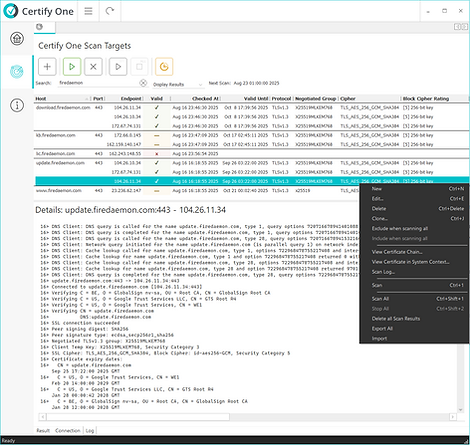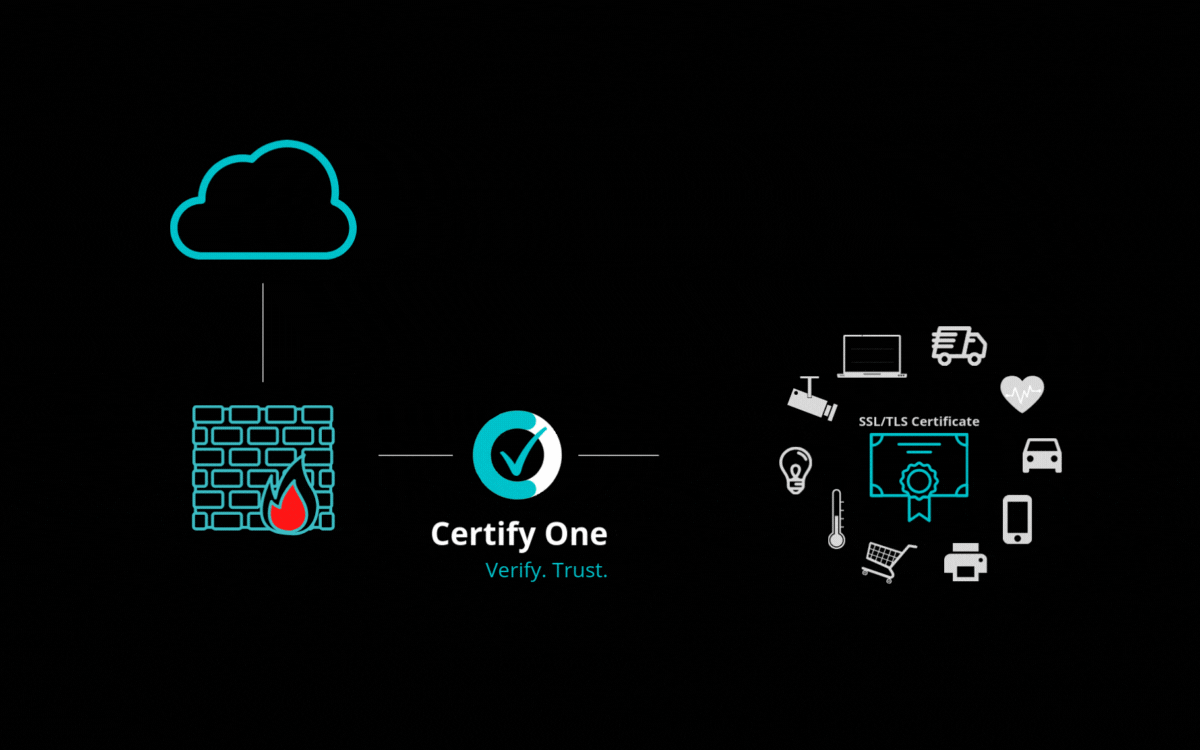FireDaemon Certify One
Quantum-ready TLS monitoring with PQC insights and compliance alerts.
✅ TLS Key Exchange Insight. View negotiated TLS groups, including quantum-resistant FIPS 203 ML-KEM secure key exchange.
✅ NIST PQC Security Ratings. Category 1–5 block cipher ratings to indicate quantum resistance.
✅ Certificate Compliance Flags. Highlight certificates disqualified under Chrome Root Program v1.6.
✅ Comprehensive Scanning. Audit multiple IPs, hostnames, ports, and service types across your network.
✅ Automated Scheduling. Run daily, weekly, or monthly scans to maintain continuous visibility.
✅ Instant Alerts. Configurable email notifications for expiring, non-compliant, or otherwise flagged certificates.
✅ Operational Reports. Dashboards and tables for internal review, operational planning, and supporting compliance efforts.

Product:
Version:
Price:
OS:
Links:
Features at a Glance
Negotiated TLS Group Display
See exactly which TLS key exchange is used, including quantum-resistant ML-KEM options.
NIST PQC Security Ratings
Category 1–5 ratings show resistance to quantum attacks.
Certificate Compliance Flags
Automatically flags certificates that breach Chrome Root Program 1.6 (e.g., mixed clientAuth + serverAuth EKUs).
Multi-Target Scanning
Audit multiple hosts, IPs, ports, and service types in bulk.
Scheduled Scans
Automate scans daily, weekly, or monthly for continuous visibility.
Email Notifications
Get alerts for flagged, expiring, or non-compliant certificates.
Operational Reports
Dashboards and tables for internal review and compliance tracking.
SSLClient Command Line
Scriptable scans, CAA DNS queries, and TLS connection testing.
Offline Operation
Scan and report without internet access.
OpenSSL 3.6 Integration
Up-to-date cryptography for SSL/TLS analysis.
Compliance for every Role
Meet Sarah
She manages IT for a small marketing agency. Certificates sometimes expire or misconfigure, causing downtime, frustrated clients, and potential loss of sales and reputation.
👉 Risk: Lost sales, revenue hits, and reputational damage when customers can’t access services.
How Certify One Helps:
-
Automated scans detect expiring or misconfigured certificates across all company sites.
-
Instant email alerts warn Sarah before downtime occurs.
-
Intuitive dashboards & reports simplify tracking and compliance.
-
Works without deep technical knowledge.
Screenshots

FireDaemon Certify One dashboard showing SSL/TLS certificate status and compliance overview

FireDaemon Certify One scan targets screen displaying endpoints, certificate chains, and scan results

Quickly check certificate validity and verify DNS CAA records directly from the command line with FireDaemon Certify One

FireDaemon Certify One dashboard showing SSL/TLS certificate status and compliance overview
Comprehensive SSL/TLS Certificate Monitoring with PQC Insights
Expired, misconfigured, or non-compliant SSL /TLS certificates can cause outages, data breaches, and operational headaches. FireDaemon Certify One simplifies SSL /TLS certificate monitoring with automated scans, instant alerts, and detailed reports, helping IT teams maintain visibility and support compliance. Beyond standard validation, it delivers quantum-era (PQC) insights: view negotiated TLS key exchange groups, including quantum-resistant ML-KEM, check NIST PQC security ratings (Categories 1–5), and flag certificates that breach Chrome Root Program v1.6 (e.g., mixed clientAuth + serverAuth EKUs), ensuring browser compliance with up-to-date OpenSSL 3.6.0 TLS/SSL cryptography.

Feature Comparison
Feature / Tool | Certify One | OpenSSL CLI | Qualys SSL Labs | Enterprise Platforms |
|---|---|---|---|---|
User Interface | ✅ Intuitive Windows GUI + Command Line tool (SSLClient.exe) | ❌ CLI only, no GUI | ✅ Web-based UI, no local client | ✅ Complex GUI + web portals |
Multi-Target Scanning | ✅ Scan multiple IPs, hostnames, ports, and services in bulk | ❌ Manual, one target at a time | ❌ Single domain only (free version); enterprise version supports bulk scanning | ✅ Bulk scanning, agent-based |
Scheduled Automated Scans | ✅ Daily, weekly, monthly customizable scheduling | ❌ None | ❌ None (free version); enterprise version supports scheduling | ✅ Enterprise-grade scheduling |
Email Notifications | ✅ Configurable, detailed alerts & reports | ❌ None | ❌ None (free version); enterprise version supports email notifications | ✅ Advanced alerting & reporting |
Detailed Reporting | ✅ Graphical dashboards, tabular data, connection logs, DNS lookups | ❌ CLI raw output only | ✅ Summary reports, limited detail (free version); enterprise version offers extensive reporting | ✅ Extensive reporting |
Command Line Interface | ✅ Included (SSLClient.exe) | ✅ Native OpenSSL CLI | ❌ None (free version); enterprise version may include CLI tools | ✅ CLI tools available |
Offline Use | ✅ Fully offline, no internet required | ✅ Fully offline | ❌ Requires internet (free version); enterprise version may support offline scanning | ✅ Typically requires connectivity; some features may work offline in internal deployments |
OpenSSL 3 Integration | ✅ Latest FireDaemon OpenSSL 3 binaries | ✅ User-installed OpenSSL version | ❌ N/A | ✅ Varies; some platforms may support OpenSSL 3 integration |
Pricing | ✅ Affordable ($49) Volume discounts apply | ✅ Free | ❌ Free (limited features); enterprise version requires subscription/licensing | ❌ Expensive, subscription/licensing |
Support & Updates | ✅ Professional support and regular updates | ❌ Community-supported | ❌ None (free version); enterprise version offers support & SLA | ❌ Enterprise support & SLA |
*Information based on testing at the time of publication. Accuracy may change as products are updated.
